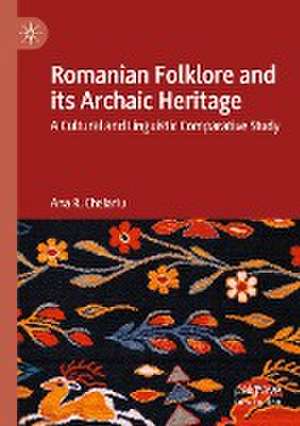Romanian Folklore and its Archaic Heritage: A cultural and Linguistic Comparative Study
Autor Ana R. Chelariuen Limba Engleză Paperback – 14 feb 2024
| Toate formatele și edițiile | Preț | Express |
|---|---|---|
| Paperback (1) | 785.24 lei 6-8 săpt. | |
| Springer International Publishing – 14 feb 2024 | 785.24 lei 6-8 săpt. | |
| Hardback (1) | 790.61 lei 6-8 săpt. | |
| Springer International Publishing – 14 feb 2023 | 790.61 lei 6-8 săpt. |
Preț: 785.24 lei
Preț vechi: 957.61 lei
-18% Nou
Puncte Express: 1178
Preț estimativ în valută:
150.27€ • 155.100$ • 125.30£
150.27€ • 155.100$ • 125.30£
Carte tipărită la comandă
Livrare economică 22 martie-05 aprilie
Preluare comenzi: 021 569.72.76
Specificații
ISBN-13: 9783031040535
ISBN-10: 3031040538
Pagini: 427
Ilustrații: XXI, 427 p.
Dimensiuni: 148 x 210 mm
Greutate: 0.54 kg
Ediția:1st ed. 2023
Editura: Springer International Publishing
Colecția Palgrave Macmillan
Locul publicării:Cham, Switzerland
ISBN-10: 3031040538
Pagini: 427
Ilustrații: XXI, 427 p.
Dimensiuni: 148 x 210 mm
Greutate: 0.54 kg
Ediția:1st ed. 2023
Editura: Springer International Publishing
Colecția Palgrave Macmillan
Locul publicării:Cham, Switzerland
Cuprins
Part I.- Chapter 1: Introduction.- Chapter 2: Brief Overview of Recent Theories on the Indo-European Homeland.- Chapter 3: Cucuteni-Tripolye: the Indo-European Homeland?.- Chapter 4: Some Recent Genetic and Archaeological Conclusions.- Chapter 5: Daco-Romanian Language - an Indo-European Branch.- Part II.- Chapter 6: The Development of Comparative Method.- Chapter 7: The Concept of Myth.- Chapter 8: Myth Between Symbol and Metaphor.- Chapter 9: Myth and Fairy Tales.- Chapter 10: Mythic time versus fairy tale time.- Part III.- Chapter 11: Traits of Indo-European Mythic Motifs in Romanian Folk Stories: Man’s Creation.- Chapter 12: Cosmogony: Fârtat and Nefârtat, the Romanian Twins among the Indo-European Divine Twins.- Chapter 13: God ‘Dumnezeu’ and the Creation of Earth, Sky, Mountains in Romanian Beliefs.- Chapter 14: The Romanian GoddessIleana Simziana: The Sun and the Moon marriage.- Chapter 15: The Sun and a Mortal Girl Marriage: the Romanian Song of Cicoarea ‘The Chicory’.- Chapter 16: The ‘Deer Hunt’ Motif in the Romanian Wedding Ceremony.- Chapter 17: Romanian Feminine Spirits: iele, rusalii, șoimane.- Chapter 18: The Romanian Păcală among the Indo-European Tricksters.- Chapter 19: The Hero Slaying the Dragon Myth and the Romanian Song Iovan Iorgovan.- Chapter 20: Youth Rivalry Fights: From Nart Sagas to the Romanian Song Mioriţa.- Chapter 21: Metamorphoses in Myth and Fairy Tales.- Chapter 22: Metamorphoses in Youth Initiation Rites.- Chapter 23: The Romanian folk story “The Enchanted Pig,” the ‘Beauty and the Beast’ motif.- Chapter 24: Indo-European Social Structures and Youth Initiation Rites in Romanian folk customs.- Chapter 25: Father Christmas - Romanian Moş Crăciun - a Solar Myth.- Chapter 26: Conclusions.- Chapter 27: The Daco-Romanian Cultural Vocabulary.
Notă biografică
Ana R. Chelariu is an independent researcher and retired former library director from New Jersey, USA. She has published several books and a number of articles on the topic of comparative mythology, and presented papers at international conferences.
Textul de pe ultima copertă
This book presents rich information on Romanian mythology and folklore, previously under-explored in Western scholarship, placing the source material within its historical context and drawing comparisons with European and Indo-European culture and mythological tradition. The author presents a detailed comparative study and argues that Romanian mythical motifs have roots in Indo-European heritage, by analyzing and comparing mythical motifs from the archaic cultures, Greek, Latin, Celtic, Sanskrit, and Persian, with written material and folkloric data that reflects the Indo-European culture. The book begins by outlining the history of the Getae-Dacians, beginning with Herodotus' description of their customs and beliefs in the supreme god Zamolxis, then moves to the Roman wars and the Romanization process, before turning to recent debates in linguistics and genetics regarding the provenance of a shared language, religion, and culture in Europe. The author then analyzes mythcreation, its relation to rites, and its functions in society, before examining specific examples of motifs and themes from Romanian folk tales and songs. This book will be of interest to students and scholars of folklore studies, comparative mythology, linguistic anthropology, and European culture.
Ana R. Chelariu is an independent researcher and retired former library director from New Jersey, USA. She has published several books and a number of articles on the topic of comparative mythology, and presented papers at international conferences.
Caracteristici
Explores a topic that is underrepresented in the English-language literature on folklore Argues that Romanian mythical motifs have roots in Indo-European heritage and language Analyzes and compares mythical motifs from the archaic cultures, Greek, Latin, Celtic, Sanskrit, and Persian
